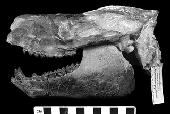|
 See More Images See More Images

Priscacara liops
© 1998 Dr. Richard Paselk, Humboldt State Unversity Natural History Museum

Archaeolagus ennisianus
© 2000 public domain

Agriochoerus guyotianus
© 1996 public domain
|
What are Vertebrates? Vertebrates, which include fish, birds, mammals, and more, are a very diverse group of animals. They come in all shapes and sizes, from the 8 millimeter-long goby (fish) to Argentinosaurus, a dinosaur that was 42 meters long. They live in all kinds of habitats, from the deep sea to the air, and from the tropics to the arctic. Some just have skin, but others have hair, feathers, scales, or other coverings. Vertebrates are chordates that have a backbone, and their fossil record extends back to the Cambrian.
Note: Their chordate relatives are discussed in Hemichordates and Chordates. First known fossil occurrence: Cambrian. Last known fossil occurrence: Quaternary. This group has living relatives. |
Fossils through time:
Choose a time period to see what life was like:
|
|